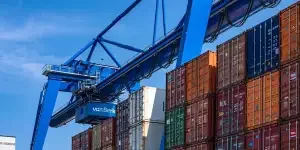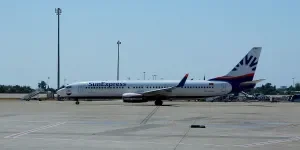The European Union (EU) has an internal single market of 27 member countries, which means that an import into one country allows those goods to then circulate freely within other EU members without further customs checks or duties. To facilitate this, import documentation and clearance processes are standardized, and accepted by all member states. For export, all member countries have also signed up to a standard export documentation and clearance process.
This article explains the process and the key documents that you will need to expedite your shipment import or export.
Table of Contents
Imports
Exports
Summary points
Imports
Customs import declaration and SAD form
The single administrative document (SAD) is a standardized form that is applied across the European Union, and is used for electronic Customs pre-alert and declaration of any imported or exported goods.
The SAD is used for trade between EU and non-EU countries and for the free movement of non-EU goods within the EU, and in certain limited cases for movement of EU goods inside the EU.
The SAD must be completed by those with direct responsibility to present the goods (the importer) together with all other required documents. The Customs declaration can be submitted by a licensed customs agent on behalf of the importer. In most cases this submission can be made electronically, although it is still occasionally used in paper versions.
The SAD form is harmonized internationally, and is used both for export and import declarations, as well as for transit through non-EU jurisdictions to a final destination, or point of exit, within the EU member countries.
The form has 54 fields for declaration, and uses standardized numeric codes to define the type of goods, quantity, destination country, and many more. One of the most important entries is the commodity code from the EU TARIC/customs tariff.
The SAD consists of eight copies, each with a different function:
- Retained by the country where the export formalities are carried out
- Used for statistics by the exporting country
- Returned to the exporter
- Retained at the destination office of any transit operation, or serves as a T2L transit document (for example when transiting between two EU countries via a non-member country)
- Return copy for the transit
- Retained by the country where destination formalities are completed
- Used for statistics of the destination member country
- Returned to the consignee
As well as the SAD, other documents required for customs clearance are:
- commercial invoice
- Authorized Economic Operator status and EORI number
- proof of origin
- Binding Tariff Information
- Binding Origin Information
- relevant certificates or licenses
- VAT and export records
Depending on the means of transport, additional documents may also be required for clearance:
- Bill of Lading, Air Waybill or equivalent
- ATA Carnet (All Forms of Transport)
- TIR Carnet (Combined Road and Other Transport)
Shipment pre-alert documents
EU regulations require traders to supply customs authorities with an electronic Entry Summary Declaration (ESD) in advance of the shipment arrival, with details on the goods being imported or exported.
This ESD allows Customs authorities to make an assessment of risk prior to the actual arrival of the goods at the port of entry, and assists authorities with their choice of subsequent checks and inspections.
EORI and VAT numbers
What is an EORI number?
An EORI number is an “Economic Operators Registration and Identification number”, which is a common identification number used across the EU for economic operators and customs authorities.
The EORI number has two parts:
- the country code for the issuing Member State
- this is followed by a code that is unique in the Member State
Businesses and individuals wishing to trade with and across the EU must use the EORI number as an identification number for all customs procedures, when exchanging information with customs administrations.
Any economic operator that is established within the customs territory of the EU must have an EORI number for customs purposes. Any economic operators that are not established within the Customs territory of the EU must also have an EORI, for a number of different situations:
- to submit a customs declaration in the customs territory of the EU
- to submit an Entry Summary Declaration (ENS)
- to submit an Exit Summary Declaration (EXS)
- to submit a temporary storage declaration in the Customs territory of the EU
- to act as a carrier for transport by air, sea or inland waterway
- to act as a carrier who is connected to the customs system, and wishes to receive customs notifications regarding submitting or amendment of any entry summary declarations
Importance of VAT Number
Imports to the EU, by any person or business, are subject to Value Added Tax (VAT). EU VAT applies to all 27 member states and is also applied on the movement of goods across EU internal borders. So for companies operating across the EU, there may be a requirement to register their business with a VAT number in more than one EU country.
Exports
Customs export declaration and SAD form
Goods being exported from the EU must do so in accordance with EU export formalities, which may in a few cases require export levies or duties. In principle, all goods being exported out of the EU, regardless of destination, must be subject to customs control before the loading of vessels. Export procedures require the exit of EU Community goods from free circulation, so that their status is revised to non-Community goods.
Exported goods must be covered by a declaration, using the single administrative document (SAD), submitted electronically. Customs undertake a risk assessment, and determine the proper routing of the exported goods, as to whether additional checks or verifications are required.
The exporter is considered to be the owner of the goods, and the person on whose behalf the export declaration is being made. Therefore, it is the exporter that is responsible for compliance with all export documentation formalities.
Shipment pre-departure documents
EU union regulations require that goods to be exported from the EU Customs territory shall be covered by a pre-departure declaration. The same form as used for import, the single administrative document (SAD), will be used to submit the pre-declaration electronically.
The export declaration should be submitted to the Customs authority within a specific time-limit before the goods are taken out of the EU. The pre-departure declaration should take the form of one of the following:
• a customs declaration
• a re-export declaration
• an exit summary declaration
The pre-departure declaration should include the details required for risk analysis for security and safety purposes.
Summary points
When shipping into or out of the European Union, it is important to know the Customs forms required and electronic systems used. Some registration will need to be completed in advance, for example to set up EORI and VAT number(s). The EU electronic processes and systems have all been set up to expedite the shipping processes for importers and exporters.
The import and export clearance procedures broadly mirror each other, with goods being presented to customs covered by a customs declaration using the SAD and supporting documents. One key difference is that on import goods are cleared for free circulation within the EU, and for export the goods are redefined as non-Community goods, i.e. they can no longer circulate duty free across the EU member states.

Looking for a logistics solution with competitive pricing, full visibility, and readily accessible customer support? Check out the Alibaba.com Logistics Marketplace today.



